JAPANESE WEDDINGS
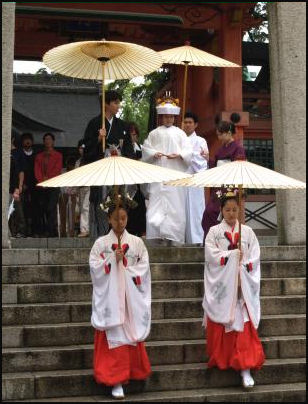
A typical Japanese wedding consists of 1) signing some papers and being presented with a certificate at a local city hall; 2) a brief ceremony; and 3) a wedding party.
Japanese wedding are notoriously expensive, Elaborate weddings features as many as five different costume changes for the bride, six-foot-high wedding cakes, champagne fountains, smoke from a dry ice machine and dinners that cost $300 a head. One of the top wedding publications is a magazine designed for women called “Zexy”.
Weddings are a $20 billion industry in Japan. A typical wedding for 50 to 100 guests in Japan costs around $30,000. It is not unusual for the cost of single wedding to exceed $100,000. One that costs between $10,000 and $20,000 is regarded as cheap. Expensive weddings are equated with high status and some families go into debt to have the most expensive wedding possible.
Japanese hotel-style weddings include a decorated aisle for the bride to walk down, a change of dress during the reception, an exchange of rings, the lighting of candles at the guests tables during the meal and a presentation of flowers by the newly wed couple to their parents,
Sometimes the bride's family pays for the wedding. Sometimes the groom's does or both families share the costs. Often one family will lobby to host the wedding and then take out a large loan to pay for it. The parents are willing to foot a big bill to avoid losing face.
Most weddings are held in hotels. In the early 2000s, it became popular to have house weddings, held at designated homes. The houses are generally mansions that can accommodate a lot of people. Even so having a wedding there is often cheaper than at a hotel.
Links in this Website: MARRIAGE IN JAPAN Factsanddetails.com/Japan ; DATING IN JAPAN Factsanddetails.com/Japan ; JAPANESE WEDDINGS Factsanddetails.com/Japan ; DIVORCE IN JAPAN Factsanddetails.com/Japan
Good Websites and Sources: Good Photos at Japan-Photo Archive japan-photo.de ; About.com on Japanese Weddings gojapan.about.com ; Marriage Customs of Japan (1897) oldandsold.com ; Weddings in the Edo Period ; Western Wedding in Japan seiyaku.com ; Ed’s Photos of Japan iipix.com ; Japan Visitor japanvisitor.com ; You Tube Video youtube.com ; Blog Report i18nguy.com/taka
History of Weddings in Japan
Modern Shinto wedding ceremonies have no religious or legal foundation. Based on the ceremony used by Emperor Taisho in 1900 when he was crown prince, they are primarily for show and were established as a Japanese version of Western wedding ceremonies.
Wedding ceremonies for ordinary Japanese remained modest affairs usually held at home until the 1960s when Japanese became more affluent and people had enough money to have weddings outside their homes.
The tradition of hosting expensive weddings reportedly began in the 1960s and was spurred by the elaborate, nationally-televised wedding of Emperor Akihito when he was Crown Prince and the future Empress in 1959, the lavish wedding of superstar actor Yujiro Ishihara and actress Mie Kitahara in 1960 and the elevation of Japan's status in the world after Tokyo hosted the Olympics in 1964.
Japanese were encouraged by hotels and wedding companies to host expensive weddings and a large number of wedding halls were built to accommodate the demand. By 1986, according to a survey by Sanwa bank, more than 70 percent of weddings were either held at hotels or wedding halls.
Wedding Preparations in Japan

wedding seminar in hotel lobby Before a marriage takes place the families of the bride and groom have a couple of meetings. The first one determines if the families are compatible. The second sets the terms for the wedding ceremony and decides who pays for what. Families sometimes investigate potential in-laws to make sure there are no whiffs of scandal.
The wedding preparations and wedding are typically overseen by a “nakodo” (an honored go-between who is usually an older, respected married man). In the old days the nakado often acted like a matchmaker in an arranged marriages. These days he is often an uncle of the bride of groom who is well liked and respected. He often acts like a best man, giving introductions, and leading toasts at the wedding party.
Engagement rings were not been part of Japanese courtship ritual until the diamond cartel De Beers created a market for them with television advertising and print ads in women's magazines beginning in the 1960s, presenting them as symbols of Western sexuality and affluence. In the 1966 only 6 percent of Japanese brides received any sort of engagement ring, and those who did usually received a pearl one. Only 1 percent received a diamond ring.
By the early 1980s, two thirds of all engaged women received a ring, and three quarters of them got diamond rings. By the early 1990s, 90 percent fo Japanese brides received a diamond ring when they got married. The Japanese retail diamond market was worth $12.6 billion in 1991, and despite the collapse of the bubble economy Japan remains the world’s second biggest market for diamonds. [Source: Washington Post]
Sundays in November are hugely popular days for getting married. The third Sunday of November (Good-Luck Sunday) is often considered particularly auspicious. The Sundays preceding “butsumetsu” (bad luck days) are regarded as unlucky and many hotels and wedding halls offer 30 percent discounts for wedding ceremonies held on these days but even then there are few takers. The New Otani Hotel in Tokyo, for example, had 27 weddings on Good-Luck Sunday one year and only three on Bad-Luck Sunday. “11-12" is auspicious because it can also be pronounced as “good husband and wife.”
Japanese Wedding Clothes
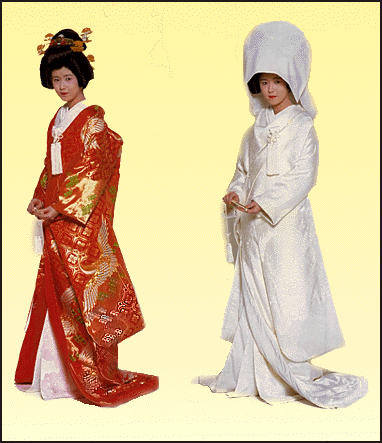
two kinds of traditional wedding dresses For a traditional Shinto wedding the groom dons a traditional black kimono for the ceremony and sometimes changes into gaudy blue or white tuxedo, like those worn by American high school boys on prom night, for the after-wedding party.
A bride that endures five costume changes wears a traditional white kimono with a white hat fixed over complex hairstyle (usually a wig) for the ceremony. Then she changes into an elaborately-designed mostly red kimono at the beginning of the reception. After the cake cut she changes into a brightly colored young-girls kimono, and later in the party dons a white Western-style bridal dress and finally puts on an Audrey Hepburn-style evening gown.
Traditional wedding costumes worn by women often includes a large white veil that conceals the "horns of jealousy" and used to include a small dagger like those used in ritual suicides in the event the bride dishonored her husband. White has traditionally been the color of wedding kimonos because white is a symbol of purity and mourning. The latter is a reference to the fact that the bride is upset over leaving her family.
The rental fee for the groom's kimono is about $600. The rental fee for the bride's five kimonos and dress can be $10,000 or more. In some rural areas brides are displayed in the window of their homes like mannequins in a store front window.
Japanese Wedding Ceremonies
A Japanese wedding is usually held at Shinto shrine, a Shinto shrine within a hotel or a wedding hall. Many hotels and wedding halls also have Christian chapels, where ceremonies are held. According to a survey by recruit Co, 70 percent of the wedding ceremonies in Japan were “western-style”; 15 percent were held at public venues; and only 12 percent were Shinto ceremonies, down from 80 percent in the 1960s.
Shinto weddings ceremonies usually last around 20 to 30 minutes. The couple is blessing by a Shinto priest, they sip some sake and a say few words. There is no best men and no giving the bride away. Sometimes rings are exchanged. After the ceremony the families of the bride's and groom are formally introduced to each other.
The wedding ceremony is usually only attended by close family members. Most of the guests for the wedding don't even show up for the ceremony. They only go to the wedding party afterwards.
Early Events at a Japanese Wedding Ceremony
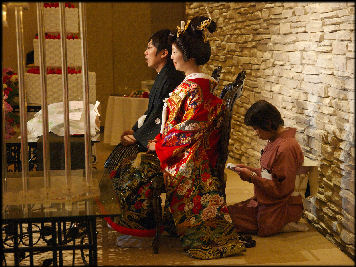
help for forgotten lines An hour so before the wedding ceremony the guests of the groom and the guests of the bride are taken into separate rooms at the Shinto shrine are coached about what they will do in the wedding ceremony. Sometimes there is a procession of sorts. In the old days gifts were taken to the grooms house in a wagon. These days sometimes they are loaded in a back of a truck.
The wedding party then enters the shrine to the sound of flute and drum music. The bride and groom sit down in front a small table near the altar. The groom’s party stands near the groom's parents next to the groom. The bride's party stands near the bride's parents next to the bride. Often there are cameras mounted on the ceiling that record the ceremony.
The formal ceremony began when all people present bow towards the alter. The priest gives a short speech and waves a “haraigushi” (a branch of a sacred tree with white linen or paper streamers attached) as a symbol of purification. The priests then chants an invocation, addressing several deities, and proclaims the bride and groom united
Later Events at a Wedding Ceremony in Japan
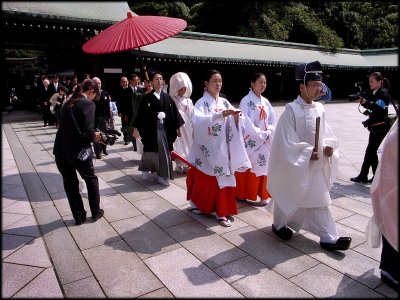
wedding procession after ceremony The main focus of the ceremony is ritual drinking of sake. A miko (female assistant of the priest) brings some sake to the bride and groom, which is poured into small cups. The grooms drinks first, finishing the sake in three sips. The bride then does the same. After this, sake is served to the groom's parents and the bride's parents. The cups of the fathers are exchanged. Everybody shares their sake and drinks and proclaim “Omedeto gozimasu” ("congratulations").
At a cue from the miko the groom reads the wedding vow: "We have now become united as husband and wife in this shrine. We respectfully pledge to make our hearts as one, give mutual help and support, faithfully execute our marital duties and responsibilities, and spend all the days of our lives together with unchanging trust and eternal affection."
The miko then reads the wedding date and the name of the bride and groom. The couple then makes a traditional offering of “tamagushi” (small branches of the sacred sakaki tree) to the “kami” (nature spirits) of the shrine. Everyone then bows twice, claps their hands two times, then bows again.
Some coupes exchange rings. Some don’t. Those that do sit at the alter and given boxes with the rings by the mikos. The groom takes the box first, opens it and places the ring on the bride’s finger. The bride then follows and does the same with the groom’s ring. After this everyone applauds. Sometimes some gifts are presented. The priest then recites an invocation and announces the successful completion of the ceremony.
Japanese Wedding Parties
Wedding parties, or receptions, are the main event of the wedding. Usually held in a special room at a hotel, they feature a sit-down meal, speeches, drinks and karaoke on a tight schedule but rarely any dancing. Large weddings are often filled with many people the bride and groom don't know. Often they are business clients or colleagues of the father hosting the wedding.
Wedding speeches are called “table speeches.” Those at the beginning are serious with everyone in attendance listening politely. Those further down the line are done between karaoke songs with the guests not listening so politely.
The nakado acts like best man, giving an important opening speech. There is often a Master of Ceremonies who announced each speech and phase of the party. Employees of the wedding company make sure everything goes smoothly, tell people what to do and where to go and help the bride and groom get dressed.
Speeches are usually given by the fathers of the bride and groom, and bosses, friends, company presidents, college professors and even high school coaches and teacher with links to the newlyweds. The speeches are usually very dull. Sometimes they can be funny if speechmaker is drunk. When speeches run too long, sometimes the MC will turn off the microphone. Some company president spend nearly every weekend at a wedding giving speeches.
The dishes of the meals are often served so fast that people don't have time to eat everything and about quarter of $100 per head meal end up in the rubbish. If you are worried about not having enough guests. No problem. There are companies that rent out wedding guests. Hotel wedding are a major business for Japanese hotels.
Wedding Party Schedule in Japan
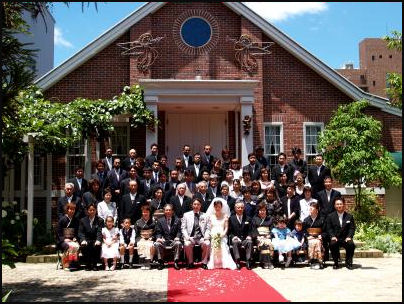
wedding picture Japanese wedding parties usually begin with: 1) the playing of Mendelssohn's wedding march as the bride and groom walk down the aisle and take their seats at table elevated above the table of the guests. This is followed by a 1) short speeches by the nakado and the Master of Ceremonies introducing the bride and groom; 2) speeches of high ranking people such as bosses and professors; 3) toasts; and 4) a cue for guests start eating.
While people are eating there are: 5) short speeches by lower ranking people during which the bride quietly slips out and 6) re-emerges, dressed in a Western-style dress, with groom. The bride may do one to three dress changes during the party. If there are three dress changes that means there is lots of drinking and eating and speeches to fill the time.
The party reaches the midway point when: 7) the bride and groom cut the cake and light a candle at each table. After that the 8) the bride and groom read a letter thanking their parents for everything; 9) then there is karaoke or some other entertainment; 10) bride and groom give flowers to their parents in law: 11) The father of the groom then thanks everyone for coming. Every one leaves.
Japanese Wedding Party Rituals and Customs
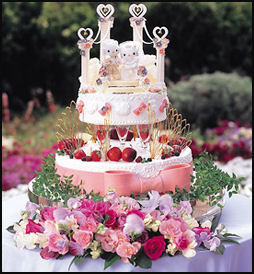
Hello Kitty wedding cake Weddings cakes are expensive. A large one can run several thousand dollars. To save money many newlyweds use a massive plastic cake that has small wedge in it containing a single piece of real cake. The cake is "cut" with the bride's hand resting on the groom to signify their first act together as husband and wife. Music is played and everyone gives a toast to the couple's good health. Pieces of cakes are brought to the guests to eat.
In another central ritual, the bride and groom go from table to table with a long-stemmed candle and light candles at each table. The guests congratulate the newlyweds and clap their hands. This gives the guests a chance to get a close up look at the bride. There is often a lot of picture taking.
In some weddings the guests approach the table where the bride and groom sit and make a toast and offer the newlyweds a drink. At large weddings the couple is sometimes given a bucket which is placed under table for the newlywed to discreetly dump their drinks into so they don't get drunk.
The bride often has a dour expression on her face during the ceremony because it is considered bad luck to smile on your wedding day. Usually the whole family looks rather dour in wedding portraits.
Sometimes the newlyweds are photographed together with a paper umbrella over their heads. This symbolizes they are lovers. Sometimes they drink a soda from separate straws.
Japanese brides generally don't throw a bouquet. It is not unusual for speechmakers for even the father-in-law to get refer to the bride by the wrong name.
Wedding Gifts in Japan
As the guests enter the party they give their wedding present, usually special envelopes with new crisp banknotes inside, to the parents of the bride and groom. The envelopes contain a decoration called a nori that used to be a piece of dried abalone. A typical gift is around $100 or $200. Many give three ¥10,000 notes (about $300) , which symbolizes the couple’s union because it can not be split. Much of the money is used to help pay for the wedding.
One unique custom at a Japanese wedding is that the bride and the groom give gifts to the guests for coming. Typical gifts include bottles or wine, tableware, travel kits, utensils, lacquerware, cakes.
Many couples are given an apartment as a wedding present. Sometimes the wedding is preceded by a small procession of pick-up trucks, bound for the apartment, loaded with furniture, kitchen appliances and electronic items.
Church Weddings in Japan
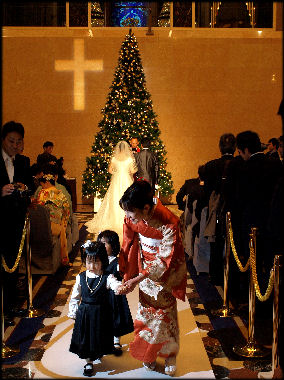
Some places in Japan have an awful lot of churches for a country that in which Christians only make up 1 percent of the population. That is because many of the churches are not real churches but fake ones built for Japanese couples to get married in. Many couples have their wedding ceremony performed in them. Other simply have their picture taken there in traditional Western wedding clothes
St, Patrick Cathedral — near Nagoya in Ichinmiya in Aichi Prefecture — is Japan’s largest “wedding church.” Model after the cathedral in Cologne, Germany and able to accommodate 150 people, it boasts a 51-meter-high spire, 27-meter-high ceiling and 30-meter-long bridal aisle. Osaka’s Monterey Grasmer Hotel recreated a model of the thatched-roof All Saints Church in Brockhampton, Hertfordshire in England.
Taro Igarashi, an architecture professor ay Tohoku University told the Asahi Shimbu, “It’s a commercial space perpetuating a fiction. All that counts is whether the materials seem real and the overall effect is church-like. That says a lot about the Japanese view of religion.”
A nationwide survey in 2006 counted 1,228 facilities that offered Christian weddings, including 589 “independent churches” capable of accommodating Christian weddings. Of these 475 had stained glass, 375 had pipe organs and a third had Gothic features. A total of 133 had ceilings 10 or more meters high and aisles 10 or more meters long, with some featuring stairs designed to show off wedding dresses with long trains.
Two-thirds of Japanese couples have Christian-style weddings. One bride who insisted on a Christian-style wedding told the Daily Yomirui, “Although Shinto was probably a bit closer to us in terms of religion, we put the look of the wedding first. I didn’t have any qualms about having a Christian-style wedding. I’d always wanted to wear a wedding dress, so I’d been thinking about having the wedding at a church in a natural setting.”
The majority of the “Christian weddings are not real Christian weddings. The minsters that conduct the, are not real ministers. Many are English teachers who are chosen because they are Westerners. One American who has presided over 600 weddings told the Daily Yomiuri, “I don’t think it bothers them at all that he’s not a real pastor. “The main thing is that you do your job completely and professionally and look the part so that they can take their photos and make their videos and whatever else it is they want to get out of it.” When couples are offered instruction in the Christian faith as background for their experience most decline.
Japanese Wedding at Disneyland and in Hawaii

Hello Kitty weddings Disney does good business hosting wedding ceremonies for Japanese presided over by Mickey and Minnie Mouse. Some couple have their wedding at Tokyo Disneyland. Other go to Florida and have it done at Disney World, where $38,000 will buy a ceremony and reception for 65 people and transportation in a horse drawn coach with footmen in wigs and gold lame pants.
Describing the scene at a Disney World wedding for a bride named Takahashi, Laura Holson wrote in the New York Times: “Ten minutes after the couple arrived, Mickey and Minnie burst through the doors with a flourish....”Mickey!” gasped Takahashi, her excitement palpable as he embraced her. The giddy couple dance with the Disney characters, who tripped over outsized shoes, Takahashi beamed when Mickey got down on his knee and kissed her hand.” When asked why she didn’t have her wedding at Tokyo Disneyland, Takahashi said, “It’s more real here. This was always my dream.”
In 2000, about 7 percent or newly married Japanese couples choose to have their wedding ceremonies abroad — five times more than a decade earlier.
Hawaii is also a favorite honeymoon destination (34 percent) followed by the mainland United States (18.9 percent), Europe (12.9 percent) and Guam and Saipan (11.2 percent). In the 1990s 60 percent of all Japanese couples who get married overseas chose Hawaii. In second and third respectively are Guam-Saipan (14 percent) and the U.S. mainland (11.2 percent).
In Hawaii, wedding ceremonies can performed in luxurious surroundings for a fraction of the price of a ceremony at a dreary wedding hall in Japan. The Honolulu telephone book lists more than 200 wedding consultants that do ceremonies on the beach with white gowns for prices that range between $500 and $5,000.
Japanese Weddings in Paris

Japanese are also heading to Paris and other European destinations to get married. A wedding at the American Church in Paris — complete with Western wedding outfits, a minister, a interpreter, a video maker and photographer — cost between $2,750 and $5,800. Extras can be chosen from a convenient online catalogue.
In most cases the weddings are not real (few Japanese meet the residency requirements for a legal French marriage). Instead the couples are married in civil ceremonies in Japan and receive “blessings, “ ”celebrations” or thanksgiving ceremonies in Paris. Many couples get married on the day they arrive in Paris on a flight from Japan that arrives at 6:30am.
About 20,000 Japanese had European ceremonies in 2006. This was about 20 percent of all overseas weddings. The weddings are attractive from an adventure and financial standpoints. With air fare included such weddings generally cost less than $10,000, considerably less than the $30,000 paid for a typical wedding at home in Japan.
In London and some other places local people have complained that such weddings have turned churches into theme parks for tourists.
An Average of $36,000 Spent on Weddings in 2011 .
Couples marrying in fiscal 2011 spent an average of 3.44 million yen on their weddings, the highest since research began in 2004, according to Recruit Marketing Partners Co. According to the firm's "wedding trends report," the average amount couples spent increased by 181,000 yen from fiscal 2009, while the average cost per guest also rose to a record 54,000 yen. "Despite the recession, wedding expenses remain high. I think people are successfully moderating their consumption," said Aya Ito, chief editor of the firm's Zexy bridal magazine. The report showed the average couple invited 73.7 guests and received 2.26 million yen in gift money in fiscal 2011. [Source: Yomiuri Shimbun, October 20, 2012]
Frugal Weddings in Japan and Weddings with Children
“Jimikon” ("frugal weddings") have also become fashionable. They often include a ceremony and a party at a restaurant or someone's home. The Chapel Green Bell in Osaka offers discount weddings with a simple service for as little as $500. Some couples are simply registering at the local city hall and not having any ceremony at all.
Those that have frugal wedding are opting for a single dress, usually a Western wedding dress rather than kimono. They are also reducing the number guests. Many of those eliminated are peripheral relatives and business co-workers.
An editor of a bridal magazine told the Japan Times, "Before marriages was considered the unification of two families, so the bride and the groom were not allowed to have a wedding the way they liked. But today, young people consider getting married as more of a personal event they want to enjoy, and their baby boomer parents don’t care much about what kind of wedding their children want to hold." Many potential wedding guest also like the trend because they don’t have to dish out expensive gifts.
The strong yen has been a boon for the overseas wedding business. Fees weddings abroad and accommodation rates have fallen significantly. For example, Watabe Wedding’s basic wedding plan in Paris fell from ¥418,000 to ¥348,000. One survey found that some couples are getting married overseas “to do something good for our parents” — i.e. save them money.
It is becoming increasingly common for couples with children’some of them already married some of them not — to get married with their children in attendance. Many who have done this had city hall paper-stamping ceremonies when they officially got married but no real ceremony because the bride was pregnant. One couple who had a ceremony with their children five years after they were officially married, because it took that long for their parents to forgive them, told the Yomiuri Shimbun, “Our three children celebrated with my wife and me. The wedding has become a wonderful memory for us all...Also, my wife and I rekindled the feelings of our newlywed days.” The trend became popular in 2009 when TV personality Takeshi Tsuruno held a wedding ceremony with his wife and children. Hotels that cater such weddings offer special rooms for diaper changing and breast feeding.
Image Sources: Ray Kitanne expect Hello Kitty ones (xorcystblog), Honeymoon stats (Jun of Goods from Japan) and wedding dresses (MIT Education)
Text Sources: New York Times, Washington Post, Los Angeles Times, Daily Yomiuri, Times of London, Japan National Tourist Organization (JNTO), National Geographic, The New Yorker, Time, Newsweek, Reuters, AP, Lonely Planet Guides, Compton’s Encyclopedia and various books and other publications.
Last updated January 2013
